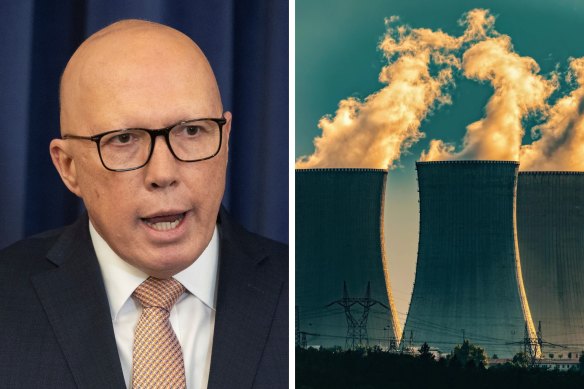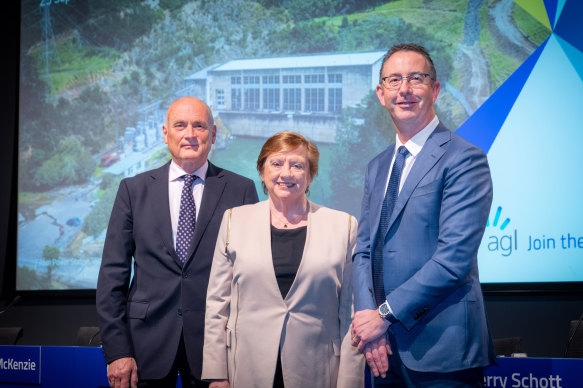By Nick Toscano
Power giant AGL says Australia has reached a critical juncture in the renewable energy transition and has no time to waste on the Coalition’s controversial pitch to build nuclear generators.
“The cost and the time of delays involved in nuclear assets are such that we simply cannot wait,” AGL chair Patricia McKenzie said on Wednesday. “We need to move ahead” with the rollout of renewables, she added.

Opposition Leader Peter Dutton has committed to build seven nuclear plants across the country if he wins the next election.Credit: Alex Ellinghausen, Getty Images
Opposition Leader Peter Dutton has earmarked two of AGL’s sites – the Loy Yang A coal-fired power station in Victoria and the decommissioned Liddell generator in NSW – among seven locations where the Coalition wants to construct nuclear power plants.
But AGL, which supplies energy to more than 4 million customers, says it will not participate in the proposal.
Addressing AGL’s annual shareholder meeting on Wednesday, McKenzie insisted government and industry leaders must double down on the “concerted effort” to install more wind and solar, backed up by batteries, hydropower assets and quick-response gas plants, in time to compensate for a fast-approaching wave of coal-fired power plant closures.
Although AGL remains eastern Australia’s biggest coal-fired electricity supplier, the 180-year-old utility is working to replace its coal plants with cleaner sources, spending billions of dollars building 12 gigawatts of firmed renewables in time for the closure of its final coal generator by 2035.

AGL chair-elect Miles George, chair Patricia McKenzie and chief executive Damien Nicks.
It is also advancing a strategy to transform its retiring fossil fuel sites into lower-carbon industrial energy “hubs” spanning renewables, grid-scale batteries and the manufacturing of green technologies that could help reduce Australia’s emissions.
AGL has already started building a 500-megawatt, two-hour battery at Liddell, and was collaborating with other potential technology partners, McKenzie said.
“We do not have nuclear as part of that plan moving forward,” she said.
At least half of the remaining coal-fired generators on Australia’s eastern seaboard are scheduled to shut in the next 10 years, while the share of renewable energy continues to grow. Wind, solar and hydroelectricity now account for more than 40 per cent of the grid’s average energy mix.
But there are growing concerns in the industry that the rollout of renewable generation and storage projects and the transmission lines to link them to major cities is still falling short of the pace required to close those generators on schedule without raising the risk of price spikes or blackouts. There are also worries that investment is falling short of the levels necessary to keep Australia’s 2030 climate targets within reach.
“We are at a critical point in the transition,” McKenzie said.
The Albanese government has set targets to double the share of renewable energy to 82 per cent of the grid and achieve a 43 per cent emissions cut by 2030. Ahead of the next federal election, the Coalition is campaigning to cut short that target, and instead build up to seven nuclear power plants to achieve Australia’s longer-term ambition of reaching “net zero” emissions by 2050.
However, the opposition leader’s pitch for nuclear – an emissions-free source of continuous power – as the solution to the country’s energy needs has encountered significant setbacks. Many industry leaders, experts and top energy officials have cautioned it is a “comparatively expensive” power source that would take too long to deploy locally, rendering it an impractical solution to the grid’s most pressing needs.
Research from the CSIRO and the Australian Energy Market Operator (AEMO) this year concluded that country’s first nuclear plant would cost up to $16 billion, and suggested the Coalition’s claim it could build one by the mid-2030s was overly optimistic. Rather, the research said, the first nuclear plant would not likely be operational until at least 2040.
AGL chief executive Damien Nicks on Wednesday said the company had nearly doubled its pipeline of potential future renewable energy and firming projects to 6.2 gigawatts over the past financial year. Among these are the Pottinger Energy Park, which is expected to include a wind and solar farm and a four-hour grid-scale battery, and a planned 400-megawatt, eight-hour pumped hydro project in Muswellbrook.
The Business Briefing newsletter delivers major stories, exclusive coverage and expert opinion. Sign up to get it every weekday morning.